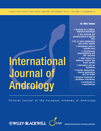Seasonal changes in testicular structure and function in the blue fox (Alopex lagopus), as quantified by morphometric analysis and measurement of adenylate cyclase activity
Abstract
The volume of the blue fox testis showed 5-fold changes during the year, associated with considerable changes in cellular composition. The seminiferous epithelium was maximally regressed in August, when 94% of tubules contained only spermatogonia. By late October, approximately 6 months before the mating season, 40% of tubules contained primary spermatocytes. From the middle of January until the end of April all tubules contained spermatids or more advanced haploid cells. Tubular diameter increased by 73% during testicular re-development, and epithelial height increased 3-fold. Regression to the basal state occurred during May to July. The volume densities of the seminiferous epithelium and of interstitial tissue remained approximately constant throughout the year. Soluble Mn2+-dependent adenylate cyclase activity showed seasonal variations that paralleled those of the haploid germ cell population and testicular volume, whereas somatic cell adenylate cyclase activity was relatively constant.




